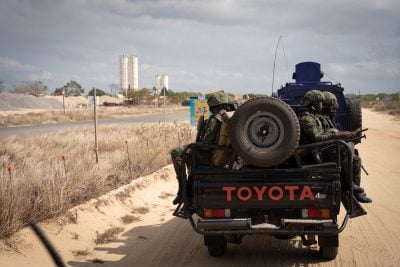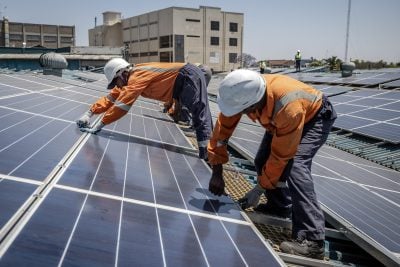With global energy focused on carbon emissions in the run-up to the Cop26 climate summit, the role of Africa in the energy transition is once again under the spotlight. As the world moves ever more decisively to cleaner energy systems, Africa is facing its own issues. Can it keep up and if it does not, will this lead to a growing energy divide?
African policymakers are grappling with big questions about how to move their countries forward, with oil and coal producers under pressure from developed countries to compromise their resource advantage in fossil fuels in favour of a big push to renewable energy.
South Africa is key among them. The biggest source of carbon emissions in Africa, the continent’s most industrialised economy has been targeted by activists for its large coal footprint, the source of about 80% of its grid energy. The country’s power utility, Eskom, is its biggest emitter of greenhouse gases even as it battles to keep the lights on, relying on power cuts and costly diesel generators to address system failures.
The reluctance of the country’s energy minister, Gwede Mantashe, to drive a transition from coal has long been a handbrake on progress in decentralising energy, although recent changes to regulation will break Eskom’s virtual monopoly by allowing independent power producers to build plants of up to 100 MW without onerous licensing requirements.
Many of the new projects could be renewable, but the country’s 2019 energy blueprint allows for the development of 1500 MW of new coal capacity. In September, climate envoys from the UK, US, Germany and France visited South Africa to offer incentives to get the country to forge a new energy deal that could be presented at Cop26. An initial amount of almost $5bn in concessional loans and grants was discussed. The minister did not meet the delegation, according to media reports.
Issues for developing countries
Rich nations, Mantashe said, should not force South Africa to ban new coal power projects and impose other conditions to reduce its carbon footprint, pointing to the power issues developing countries have faced in the recent past.
“We are a developing economy. We must have a clear programme. We must navigate the transition carefully.”
He echoes what some other countries, also richly endowed with fossil fuels, are thinking. There are still many countries that rely on fossil fuels for their baseload energy even while they court renewable targets. These include Zimbabwe, Namibia, Nigeria, South Africa, Tanzania and others.
Hydropower is a significant part of the energy mix in Africa, but unpredictable weather patterns have affected its viability as a main source of generation. Droughts in recent years in Ghana, Zimbabwe, Tanzania and Kenya, for example, have brought water levels below the turbines at times, causing energy crises.
Reliable energy is a luxury in Africa and a survey by Energy for Growth Hub, a global solutions connector, shows that more than 53% of firms in sub-Saharan Africa rely on self-generation as a back-up to grid power.
How Africa meets its growing energy needs is crucial for the continent’s economic and energy future and will have an impact on global trends. Rapidly growing urbanisation and high population growth – 2.45% in 2021 – means more than half a billion people will be added to Africa’s urban population by 2040.
Already, an estimated 600m people out of a continental population of about 1.2bn do not have access to reliable power and in many cases, any power. The latter rely on time-worn solutions including charcoal, candles, kerosene and generators to get by. This is despite the stated ambition for universal access in Agenda 2063, the continent’s 50-year development plan forged in 2015 and incorporated into the national planning framework of more than 30 countries.
The African Development Bank is at the forefront of efforts to effect an energy transition, investing in helping countries end their coal dependence and driving its new deal on energy for Africa. This includes mobilising domestic and international capital for innovative financing for energy; helping African governments to strengthen energy policy, regulation and sector governance; and increasing its own investments in energy and climate financing.
As governments align their energy strategies to the UN Sustainable Development Goals (SDGs), there is pressure on them to build climate-friendly energy systems. Most countries now have targets for the contribution of green energy in the total mix.
Rise of renewables
Despite South Africa’s intention to keep exploiting coal, its Integrated Resource Plan envisages renewable energy contributing up to 42% of new generation by 2030. Indeed, the country has one of the most progressive renewable energy programmes on the continent – the Renewable Energy Independent Power Producer Procurement Programme (REIPPPP), which provides a template for other African countries.
Launched in 2012, REIPPPP has attracted over $20bn investment in energy infrastructure. It had procured new capacity of 6422 MW by December 2020 in four main bid rounds, and a fifth is currently under way. The programme has a strong social and development focus, with strict empowerment and local content targets and shareholdings set aside for black South Africans.
Kenya is also well ahead, with 70% of its energy already coming from renewable sources in the form of geothermal and hydro power. North African countries are using their huge solar capability to best effect.
The role of gas in the clean energy debate is still unclear. It was considered to be a bridging fuel source between dirty fossils and renewables, but many critics are sceptical as climate targets get tougher. However, it is becoming an increasingly important source for Africa as well as a major export product from gas reserves in offshore areas, including South Africa, Mozambique and Tanzania. Nigeria, the continent’s biggest oil producer, also has significant gas reserves, which it is prioritising in its energy mix going forward.
Towards a proactive energy transition
Cop26 is likely to deliver even more ambitious climate pledges and with them new regulations that may have serious implications for businesses in the coming years. Renewed and more ambitious climate pledges by governments will spur new regulations, support green innovation and make additional financing available.
There is the danger of a growing energy and trade divide if countries cannot meet emissions requirements set by their main trading partners in developed countries. As industries such as shipping and aviation seek more carbon-friendly solutions, African destinations may struggle to service them. Already, new refined fuel specifications are threatening the viability of older refineries on the continent and there are concerns about high tariffs being imposed on carbon-heavy goods in time.
Developed countries have pledged to mobilise $100bn per year for climate action in developing countries, but the question is whether many hard-hit nations in Africa have the plans or capacity to absorb this money. The reinvention of global energy companies as green energy players offers an opportunity. Many have deep roots in Africa and can play a role in driving the continent towards a more emissions-free future.
But it is critical that those who have the power to direct policy and regulation are the ones who are most convinced of the need for a proactive energy transition in Africa. Not only is this important in terms of the global climate project, but it is also critical for local empowerment and job creation as opportunities open up in decentralised and tech-driven energy generation and services.
Read more about the future of African energy in our special report.
Want to continue reading? Subscribe today.
You've read all your free articles for this month! Subscribe now to enjoy full access to our content.
Digital Monthly
£8.00 / month
Receive full unlimited access to our articles, opinions, podcasts and more.
Digital Yearly
£70.00 / year
Our best value offer - save £26 and gain access to all of our digital content for an entire year!
 Sign in with Google
Sign in with Google 



